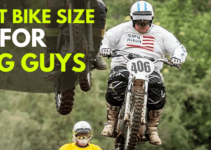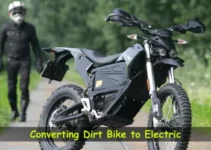“A family that rides together stays together!”
I am sure that every dirt biker’s love for family is pure when it comes to dirt bike camping. There are a plethora of outdoor activities. One is dirt bike camping, an outdoor adventure to enjoy the thrill of dirt biking with friends and family. You can spend the whole night and the next day out-of-the-way location. You can camp in a mountain resort or near a popular trailhead.
If dirt bikers get the opportunity once in a lifetime, they would like to go dirtbike camping. You can tackle the terrains at night or dawn to catch the beauty of sunset and sunrise. With two-wheeled riding experience, you’ll learn the lesson of responsibility and independence. In this case, the ultimate dirt bike camping guide will make your next trip comfortable and enjoyable. It’s all that you need.
Keep on reading!
What is Dirt Bike Camping?
Dirt bike camping is like other camping, but the main difference is the dirt biking. In dirt bike camping, you can stay overnight at campsites like a popular trailhead, lodge, forests, BLM land, or mountain resorts. Dirt bike camping allows enthusiasts to immerse themselves in nature, access hard-to-reach areas, and experience freedom.
Ensure you’ve packed light gear like a compact tent, mat, sleeping bag and food for dirt bike camping.
The Benefits of Dirt Bike Camping
Why should I try dirt bike camping? The simple answer to this question is that you can explore the popular, hard-to-access places and rewarding outdoor activities through dirt bike camping. The Dirt biking at dawn and sunset is simply fascinating.
So here’re the few benefits of dirt bike camping:
1. Bond with Friends and Family Members
Dirt bike camping strengthens bonds with friends and family. You’ll have to work together to set up the camp, cook food and ride the trails together. Shared adventures, teamwork, and quality time create lasting memories.

2. Challenge Yourself
Dirt bike camping offers opportunities to challenge yourself and grow. Conquer difficult trails, overcome fears, and enhance your skills. Build resilience, boost confidence, and discover your true capabilities.
So dirt bike camping can be challenging as well as fun for you. You’ve to be prepared for technical issues in bad weather conditions.
3. Testing Your Dirt Bike
During dirt bike camping, test your skills and the limits of your dirt bike. It conquers challenging trails, navigates difficult terrain, and practices technical maneuvers. Embrace the chance to grow as a rider and become more proficient on your dirt bike.
4. Enjoy Outdoor Yummy Food
Dirt bike camping offers the benefit of enjoying delicious outdoor food. It enhances the camping experience, connects you with nature, and provides energy and nutrition for riding. So you can enjoy some amazing outdoor food with your friends and family.
5. Explore the Places
Dirt bike camping allows you to get more riding inside adventurous places. You can camp in the most beautiful places, only discovered by dirt biking.
6. Sense of Accomplishment
You will feel accomplished finding your destiny after many challenges whenever you reach the camping site. You’ll feel proud of yourself for finally reaching the beautiful place for camping.
The Different Types of Dirt Bike Camping
Dirt bike camping offers various ways to enjoy the outdoors and combine the thrill of riding with the camping adventure. Here’re different types of dirt bike camping you can explore:
1. Dual-Sport Camping
Dual-sport camping involves using a dirt bike to handle both on- and off-road trails to explore various riding routes and camps. Therefore, you can ride on dirt trails and paved roads with a dual-sport bike.
So you can explore scenic backroads, remote areas, and off-the-beaten-path destinations. During dual-sport camping, you can carry essential camping gear on bikes, such as tents, sleeping bags, and cooking equipment.

2. Backcountry Camping
Backcountry dirt bike camping involves venturing deep into the remote, away from the roads and rugged areas. It offers an immersive experience away from established campgrounds. Backcountry campers have a connection with nature. It’s popular among outdoor enthusiasts seeking a deeper wilderness experience.
Backcountry camping is a great way to experience the wilderness and escape the hustle and bustle of everyday life. However, backcountry camping is only for some. It considers a lot of planning and preparation and can be dangerous if you need to be properly equipped.
Things that you need to do for backcountry camping are listed as:
- Choose a campsite carefully
- Be prepared for uncertain bad weather
- Be aware of the wildlife surroundings
- Leave no trash after camping
Moreover, Dual-sport and adventurous dirt bikes are mostly preferred for backcountry camping and riding.
3. Trailside Camping
Trailside camping involves setting up camp along designated off-road trails or trailheads. Trailside camping is sited at hiking or biking trails. Riders can set up camp nearby instead of returning to a separate campground or base camp. Therefore, they can relax, refuel, and recharge before continuing their ride.
Some trails have designated campsites with basic requirements like fire pits, picnic tables, and restroom facilities. Trailside camping is the best way to observe and relish the beauty of nature. No matter what type of dirt bike you choose, opting for a well-maintained dirt bike is essential. This will help you to have an enjoyable trip.
4. Enduro Camping
Have you ever experienced camping in the wilderness? If your answer is No! Then I suggest you go for enduro camping to explore a variety of terrains, including forests, hills, and challenging off-road sections.
Enduro-campsites are strategically located along the race route, providing riders with a designated area to set up camp and prepare for the next stage. These campsites may include tent spaces, mechanics’ areas, and support services.
In enduro camping, you should ride enduro dirt bikes. They’ve larger fuel tanks, durable suspensions, and more power for off-road enduro camping.
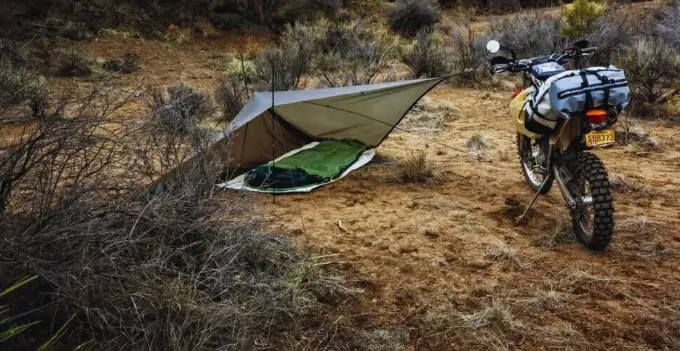
5. Base Camp Camping
Base camp camping is where riders set up a main camp and venture out to explore specific areas in depth. In base camp camping, riders choose a suitable location as their base and set up their campsite with tents. This central camp serves as a home base where riders can return after each day’s ride.
Overall, base camp camping doesn’t require constant packing and unpacking. It offers comfort for the riders. Therefore, this is the most preferred type of camping by hikers, backpackers, and climbers.
The Best Times of Year to Go Dirt Bike Camping
Dirt bike camping combines the thrill of off-road riding with the adventure of camping outdoors. The best times of year to go dirt bike camping can vary depending on your location, weather conditions, and personal preferences. However, here are a few general recommendations:
1. Spring (March-May)
Spring can be an excellent time for dirt bike camping in many regions. The weather is typically mild, and nature comes alive with blooming flowers and greenery. It’s a great time to explore trails and enjoy the beauty of the outdoors before the summer heat sets in.
Spring is generally a fantastic time for dirt bike camping in the United States. However, it’s important to note that weather patterns can vary across the country. So it’s always wise to check the specific region you plan to visit for accurate weather forecasts.
With the melting snow from winter and the occasional rainfall, the trails are well-groomed and offer excellent riding conditions. Be sure to research trail conditions and closures in your chosen location because some areas may have restrictions due to spring runoff or maintenance work.
2. Fall (September-November)
Fall is another popular season for dirt bike camping. The temperatures are generally cooler, making riding more comfortable. The changing colors of the foliage create a stunning backdrop for your adventures. Additionally, many areas have fewer tourists during the fall, providing a more serene camping experience.
In different regions of the United States, the landscapes transform into vibrant shades of red, orange, and yellow. Riding through forests and wooded areas during this season can be an incredible visual experience. Remember to plan and check for any seasonal restrictions or closures. Ensure you have appropriate gear and safety precautions for your dirt bike camping trip.
3. Winter (December-February)
Winter (December-February) is generally not the ideal season for dirt bike camping in most parts of the United States. However, some exceptions and considerations may depend on your location and specific circumstances. Riding in extremely cold conditions can be uncomfortable. It’s important to dress appropriately in warm, insulated gear and have proper cold-weather camping equipment.
Winter often brings snow and icy conditions to many areas, making dirt biking challenging or even impossible in certain locations. Winter days are shorter, which means fewer daylight hours for riding and setting up camp.
If you are considering winter dirt bike camping, it’s crucial to research the specific region you plan to visit thoroughly. Some areas may offer more suitable winter riding and camping conditions, particularly in warmer climates or lower elevations.
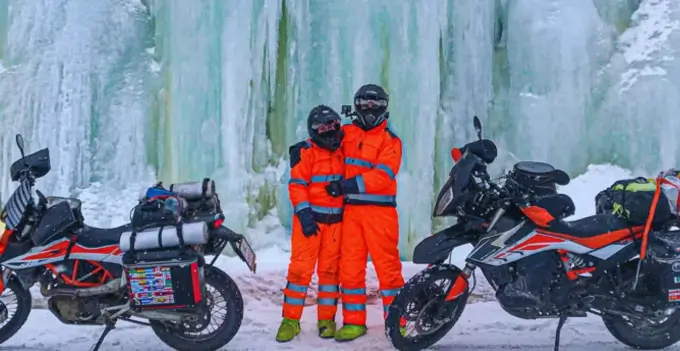
How to Find the Right Dirt Bike Camping Destinations
It doesn’t matter which part of the country you live in. It matters when you know the best dirt bike off-road camping sites. Every country or state offers a dirt bike camping destination worth exploring.
The United States offers bike lovers many recreational and backcountry dirt bike camping opportunities. Here we present the ten most wonderful dirt bike camping destinations in the US for dirt bikers’ thrillers:
1. Imperial Sand Dunes, Located in Glamis, California
Imperial Sand Dunes, also known as Glamis Dunes, is in southeastern California. This area is popular for its vast expanse of dunes, offering thrilling riding opportunities for dirt bike enthusiasts. The dunes have heights of up to 300 feet. The length of the dune may be 40 miles, and the width is 5 miles.
To camp at Glamis, you’ll need an Imperial Sand Dunes Recreation Area permit, which can be obtained online or at nearby vendors. Be sure to check the current fees and regulations for camping and riding.
Aside from dirt biking, Glamis offers opportunities for other recreational activities such as sandboarding, ATV riding, and exploring the vast desert landscape. So, the Glamis is one of the world’s best places to experience a desert ride.
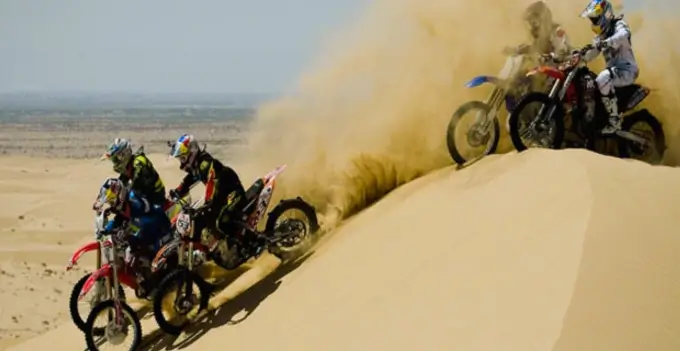
2. Moab, Utah
Moab is located in a town in Utah and is renowned for its stunning red rock landscapes and diverse off-road trails. Moab offers a wide range of trails suitable for dirt biking, catering to different skill levels. The area is famous for its slickrock terrain, challenging climbs, and breathtaking scenery.
Surely, it is an ideal area for enduro camping. Its surrounding area has many national parks and rock trails. Utah hosts many annual competitions, including Rally on the Rocks. I suggest you visit the most popular dirt bike trails like Chicken Corners, Poison Spider Mesa, Hell’s Revenge, Hidden Valley, Pritchett Canyon, and Golden Spike.
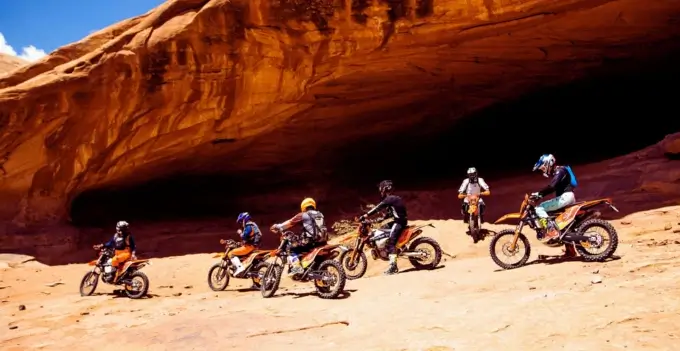
3. Taylor Park, Colorado
If you want to go for dirt bike camping, the ultimate trail is Taylor Park, situated in Colorado. Taylor Park is heaven for most Jeepers, dirt bikers, UTVs and ATVs. It provides a giant playground for off-road riders.
There’re a lot of trails for hiking, camping and climbing. Therefore highly recommend to you for one or couple of weeks to enjoy there. There’reSeveral camping options are available in Taylor Park, including established campgrounds, dispersed camping areas, and RV parks.
4. Wayne National Forest, Ohio
Ohio is the opposite of the Moab. But it has more beautiful trails to be enjoyed. It’s an expensive trail system of Ohio, including rough Midwestern dirt and deciduous forests. If you want to camp in a peaceful and quiet place, you should choose Wayne National Forest for dirt bike camping.
Do You Know? Wayne National Forest is situated in three units with boundaries of 833,990 acres.
5. Windrock Park, Tennessee
Windrock Park is located in Oliver Springs, Tennessee, on 72,000 acres of diverse terrain. The park has an extensive system of trails specifically designed for off-road riding, including dirt bikes.
The trails range from easy to challenging, catering to riders of all skill levels.
Windrock Park provides various camping options, including both primitive and developed campsites. There are designated areas for tent camping, RV camping, and even cabins for rent. You can easily run your dirt bike or jeep through this park. It’s the easiest trail in the United States.
Additional Tip: You can purchase a trail map or download the Windrock Park App to have the trail map in your hand for easy access.
6. Red River Motorcycle Trails, Texas
Red River Motorcycle Trails is located in Bulcher, Texas, near the Texas-Oklahoma border. It was established in August 1972. The area offers diverse terrain and scenic landscapes. The trails cater to dirt bikes and off-road vehicles, providing a mix of terrains, including wooded areas, rocky sections, and open trails.
The park offers camping facilities, including both primitive and RV-friendly campsites. There’re sites for dirt bike camping and sites with electrical hookups for RVs. Some sites may have picnic tables, fire rings, and access to water.
This park opens only on weekends. Therefore you’ve to get an appointment before reaching there.
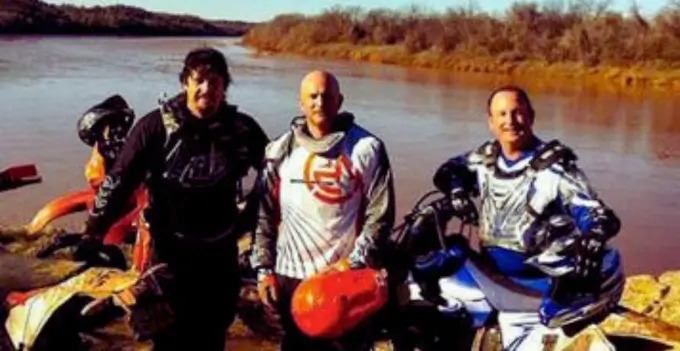
7. Ogemaw Sport and Trail Center, Michigan
When planning a dirt bike camping with your family, go to Ogemaw Sport Trails. Ogemaw Trails is located in Rose City, Michigan, offering a beautiful natural setting and a variety of trails for dirt biking. It’s a great place for youth to test their riding skill.
Under the age of 12, no kids can go for this track. Kids can play baseball or basketball there. They can climb the mountains too. Ultimately, Ogemaw Sport and Trail Center is a family-friendly destination for outdoor activities and dirt bike camping.
8. Hatfield-McCoy Trails, West Virginia
Hatfield-McCoy Trails is located in southern West Virginia, with 700 miles of trails across multiple trail systems. The trail systems at Hatfield-McCoy cater to dirt bikes and off-road vehicles, providing a diverse range of trails suitable for all skill levels. There’s something for everyone, from scenic forested paths to challenging hill climbs.
Hatfield-McCoy Trails offer various camping options, including primitive campsites, RV sites, and cabins. Some trail systems have designated campgrounds with restrooms, showers, and picnic areas.
9. Sawtooth National Forest, Idaho
Sawtooth National Forest is in central Idaho, covering many rugged mountains, forests, and lakes. The forest provides a variety of trails suitable for dirt biking, ranging from beginner-friendly to challenging terrains. Explore the network of trails and enjoy the scenic beauty of the area.
Sawtooth National Forest offers various camping options, including developed campgrounds and dispersed camping areas. Some popular campgrounds within the forest include Redfish Lake Campground and Stanley Lake Campground.
Can I camp anywhere in the Sawtooth Mountains? Yes! You can camp anywhere in Sawtooth mountains but keep in mind to leave no trace after leaving. Try to avoid camping on meadows and vegetation.
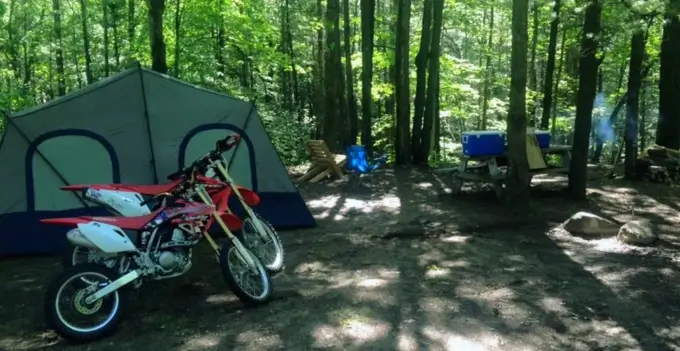
10. Moro Plantation, Northern Maine
Can I ride my dirt bikes on Maine trails? The answer is YES! But riding a Dual-sport dirt bike for comfortable dirt bike camping would be best.
Moro Plantation is situated in Aroostook County, in northern Maine. It gives a setting with vast forests and scenic landscapes. The area surrounding Moro Plantation provides an extensive trail network suitable for dirt biking. Explore the rugged terrain and enjoy riding through the beautiful wilderness.
There’re various camping options available in the territory of Moro Plantation. Look for established campgrounds or dispersed camping areas for dirt bike camping. Check for facilities like picnic tables, fire rings, and access to water.
Do You Know? According to the United States Census Bureau, the plantation has a total area of 36.5 square miles.
Some additional dirt bike camping destinations are:
- Black Hills National Forest, South Dakota
- Mud Creek Off-Road Park, Jacksonville, Texas
- Moser Creek Trail Head, Hyalite, Montana
- Grand Canyon National Park, Arizona
- Denali Highway, Alaska
Planning Your Dirt Bike Camping Trip
You’re probably thinking about dirt bike camping at your favorite destination. But the question is, how do you go camping on a dirt bike? Whether you want to carry everything on your dirt bike camping or just set up a tent for the weekend. The ball is in your mouth to decide which you want to do first.
If you’re going for day dirt bike camping, you must track your luggage daily on the dirt bike. But to make a week-long dirt bike camping trip, pack your camping gear on your dirt bike.
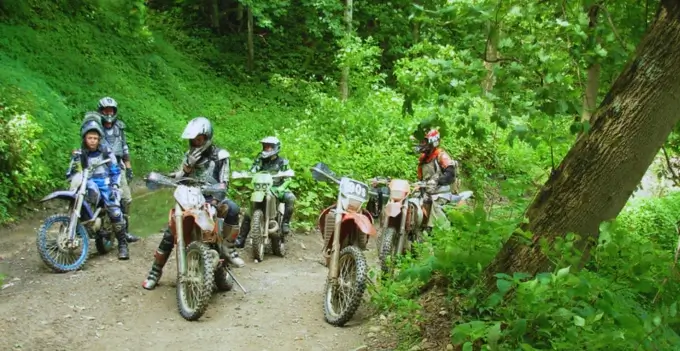
What gear do you need for dirt bike camping?
An outdoor camping trip is pleasurable. Before you leave the house, you need to pack some camping gear on your dirt bike. It depends on your trails and the things you may need to take. Remember everything you need to pack with you. Remember something at home.
Here is the check-list of the camping items of Dirt Bike Camping (The Ultimate AdventureTips):
- Tent for camping
- Sleeping bag
- Sleeping pads
- Camping pillow
- Cargo net
- Lantern and batteries, if needed
- Durable clothes and shoes
- Food and cooking supplies
- water
- Camping Stove
- Utensils like plates and cups
- Multi-tool knife
- Extra fuel
- High-quality cooler
- Bug spray
- First aid kit
- Canopy
- Toothbrush and toiletries
- Soap
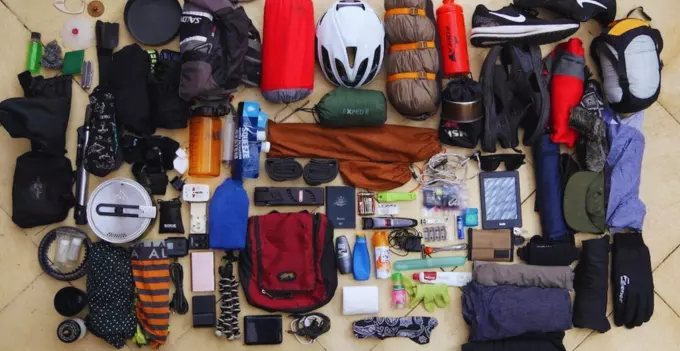
Dirt Bike Camping Tools
It’s important to keep your dirt bike tools with you, even if it is new and well-serviced. The dirt bike wheels may become flat in rough terrains, and you need some tools to fix them. Here is the list of essential camping tools:
- Fender bag with spare tube
- Tool Kit
- Fanny pack
- Tools for removing/changing a tube
- Hand air pump
- Electric Portable Air Compressor
- Trucker’s Friend Survival Axe

How to pack for a dirt bike camping trip?
When the riders want to enjoy dirt bike camping and have made a list of essential gear to take with them, a question arises, how do you pack a bike for dirt bike camping? Some people pack their luggage at random and unplanned times. Then disorganized packing caused the dirt bike ride to unbalance. Therefore, it’s important to pack your essential gear and tools perfectly and organize them so you may travel fast toward the destination.
Packing your dirt bike requires a smart strategy to distribute the weight equally. An over-loaded dirt bike will never handle the balance and comfortable journey. But if you can pack well, you will successfully navigate off-road terrains.
Tips to Pack for Bikepacking
a. Balance weight between front and rear.
The weight should be evenly distributed between the front and rear of the bike to maintain balance. Place heavier items closer to the bike’s center of gravity, typically near the bottom bracket.
b. Put the heaviest items low in the frame pack.
Overloading the bulky items in your seat pack may hurt handling dirt bikes. The bike packers are advised to put the heaviest items like a sleeping bag, stove, bike tubes, fuel, and extra food at the bottom.
The dirt bike frame pack will help you to keep the gravity towards earth to maintain the bike’s handling.
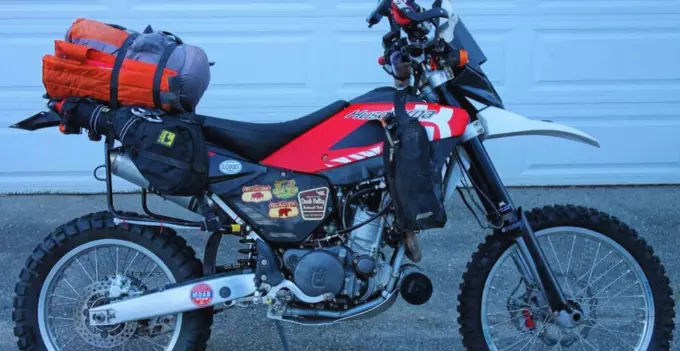
c. Put the lightweight at the handlebars pack.
Using a handlebar bag to store lightweight and frequently accessed items like a map, GPS device, snacks, or a camera. Make sure that the bag is securely attached. It’ll not obstruct your view or interfere with your braking and shifting.
d. Keep the frequently used items within reach.
Pack items you may need during the ride, such as snacks, cell phones, rain jackets, or cameras, in easily accessible places. It saves time and allows you to access essentials without unpacking everything.
e. Secure larger items with bungee cords or straps.
After putting all your items on the dirt bike, use bungee cords or straps to secure larger items. These may be a tent or sleeping bag to the rear rack or handlebars. Ensure the items are tightly strapped and won’t shift during the ride.
Common Additional Storage Options for Bikepacking
| Storage Options | Detail |
|---|---|
| Top tube bags | Top tube bags are great for holding small items like energy bars, sunscreen, lip balm and a phone. |
| Stem bags | Stem bags are small bags that attach to the stem of your bike’s handlebars. They commonly store easily accessible things like water bottles, snacks, or small tools while riding. |
| Bottle cages | Standard bottle cages are essential for carrying water while dirt bike camping. When choosing a bottle cage, consider weight, durability, and compatibility with your bike’s frame. |
| Cargo cages | Cargo cages are like bottle cages. They’re designed to carry gear or larger water bottles. Cargo cages are often mounted on the bike frame’s fork, downtube, or seat tube, providing convenient storage. |
| Backpacks | Backpacks are a popular choice for dirt bike riders. They’re worn on your back while dirt bike camping. Therefore, pack lightweight items in your backpack. |
| Additional Packing Tips | Give bike-packing a test run, don’t overpack, trim weight |
How to plan a safe and successful dirt bike camping trip?
How can you be safe while dirt bike camping? Planning a safe and successful dirt bike camping trip involves precautions and consideration of various factors. Here’s a guide to help you plan:
1. Research the Area
You must be more cautious when you want to dirtbike camping with your friends and family. So try to select a suitable camping location that permits dirt biking. Research the terrain, difficulty level, weather conditions, and required regulations or permits.
2. Check Your Dirt Bike
Whether your dirt bike is brand new or used, check your dirt bike before leaving home. Therefore, inspect brakes, tires, chains, and suspension. As discussed earlier, you should carry the necessary tools and spare parts for any potential repairs.
3. Pack Essential Gear
Backpack your dirt bike with the essential gear and tools listed above. Bring appropriate safety gear such as a helmet, goggles, gloves, and protective clothing. Carry tools, spare parts, a first aid kit, and emergency supplies. Pack camping equipment, food, and water for your trip.
4. Plan Your Route
Always plan before choosing your dirt biking route carefully. So consider your skill level, the time available, and the terrain. Obtain maps or GPS devices to navigate the trails.
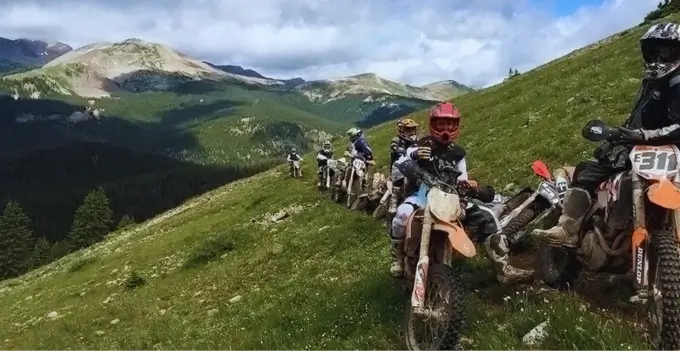
5. Check Weather Conditions
Is there anything better than dirt bike camping with your friends? Nothing is delightful except camping with your friends and family members. You can do anything for the safety of them.
Therefore, you should be updated on weather forecasts for your camping period to avoid emergencies. Avoid riding in severe weather conditions that pose risks or make the trails unsafe.
6. Carry a Communication Device
Always bring a helmet communication device such as a mobile phone or a two-way radio for emergencies. Ensure you have a way to contact help if needed. You should be in contact with your mates while riding, even in a normal situation.
7. Stay Hydrated and Nourished
Drink more water to stay hydrated during your dirt bike riding. Remember to carry high-energy snacks or meals to maintain your energy levels.
8. Be Aware of Wildlife and Hazards
While passing through the wilderness, you should be more calm and peaceful in riding. In this way, no wildlife would be disturbed, and no danger will be created for you.
Therefore, familiarize yourself with the local wildlife and any potential hazards. Take precautions to avoid encounters with animals.

9. Follow Camping Guidelines
Observe camping guidelines and regulations specific to the area. Set up camp in designated areas, and use established fire rings.
10. Leave No Trace
Lessen your effect on the natural environment by following Leave No Trace principles. Respect nature and leave the camping area as you found it.
11. Have Emergency Plans
Keep in mind any emergency occurs on the camping route. Keep a first aid box. You should know the nearest medical facility’s location and plan to contact emergency services if needed.
Tips and Tricks for Dirt Bike Camping
There are a few things that you should keep in mind. Some top tips and tricks for dirt bike camping are explained:
How to Find Good Trails?
- Utilize online resources like websites, forums, and social media groups dedicated to dirt biking and off-road riding.
- Look for trail recommendations, reviews, and discussions from fellow riders who have experienced dirt bike camping.
- Visit the websites of state and national forests in your desired location. These websites often provide information on trails, camping options, and any specific regulations or permits required for dirt biking.
- Explore trail directories and smartphone apps dedicated to off-road riding and trail mapping. These resources often provide comprehensive information on trail difficulty, length, elevation, and user reviews.
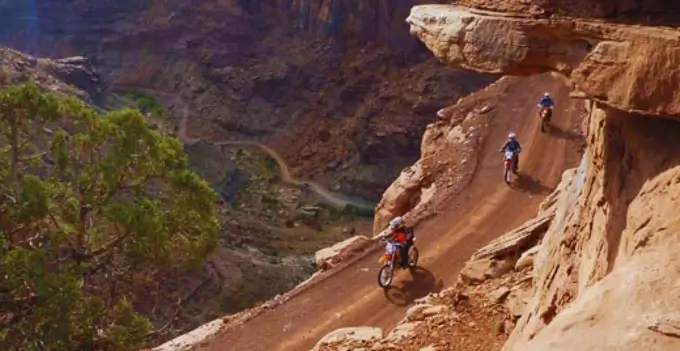
How to Stay Hydrated and Fed?
- Drink water regularly to prevent dehydration, even if you don’t feel thirsty.
- When sweating excessively during rides, you may need to replenish electrolytes lost through sweat. Carry electrolyte tablets or powders to add to your water, or consider sports drinks that balance electrolytes.
- Pack various lightweight, non-perishable snacks rich in nutrients and provide sustained energy. Examples include energy bars, trail mix, dried fruits, nuts, and jerky.
- Opt for dehydrated meals designed for camping. These meals are lightweight, compact, and require minimal preparation. Just add water and let them rehydrate before consuming.
- Pack lightweight cooking equipment such as a camping stove, cookware, and utensils if you prefer to prepare your meals. It allows you to have more variety in your food choices and enjoy warm meals.
- Consider easy-to-cook meals, pre-packaged foods, and meals that require minimal ingredients and preparation.
How to Deal with Wildlife?
- Research the wildlife species’ behavior, habits, and specific encounter precautions or guidelines.
- Maintain a safe distance from wildlife and observe them from afar. Use binoculars to get a closer look without disturbing or endangering the animals.
- Never feed wildlife, as it can disrupt their natural behavior and create dependence on human food.
- Properly store food and trash in sealed or bear-resistant containers, if necessary. It helps prevent wildlife from being attracted to your campsite.
- Avoid camping or riding in sensitive wildlife habitats, nesting areas, or restricted zones.
- If animals approach you, remain calm and slowly back away, giving them a clear escape route.
- Be aware of signs of wildlife presence, such as tracks, droppings, or vocalizations.
How to Camp in Comfort?
- Invest in a good-quality tent that suits your needs. Look for features like easy setup, sufficient sleeping and gear storage space, good ventilation, and waterproof materials.
- Use a comfortable sleeping pad or air mattress to cushion your body from the ground. Look for natural features like trees or rock formations that can provide shade or windbreaks.
- Bring lightweight and compact camp chairs and tables for comfortable seating and dining.
- Set up a convenient cooking area with a camping stove or grill.
- Ensure you have proper lighting for your campsite. Pack headlamps, lanterns, or portable LED lights to illuminate the area and provide visibility during the evenings.
- If permitted and safe, build a campfire for warmth and ambiance.
- If desired, maintain personal hygiene by bringing biodegradable soap, wet wipes, and a portable shower system.
- Pack appropriate clothing layers for varying weather conditions.
- Bring items for relaxation and entertainment, such as books, games, or musical instruments. These can provide additional comfort and enjoyment during downtime at the campsite.
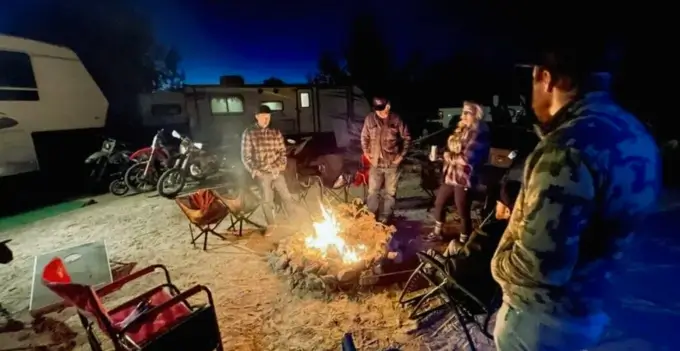
Conclusion
If you’re a dirt bike lover, you’ll love dirt bike camping along with the best dirt bike camping destination. Whether it’s the Imperial Sand Dunes in California, Moab in Utah, or Taylor Park in Colorado, each destination presents its unique charms and challenges for riders.
When you plan a dirt bike camping, you should go searching for resources for dirt bike camping. If you still need to do it, dirt bike camping is the best option you must try. Try not to overpack.
Have a joyful dirt bike camping!
FAQ’s
What are some of the most popular dirt bike camping destinations?
The most popular dirt bike camping destinations are:
- Glamis Sand Dunes, California,
- Moab, Utah
- Pismo Beach, California
- Oakridge, Oregon
- Bend, Oregon
- Durango, Colorado
- Paiute Trail, Utah
- Hatfield-McCoy Trails, West Virginia



